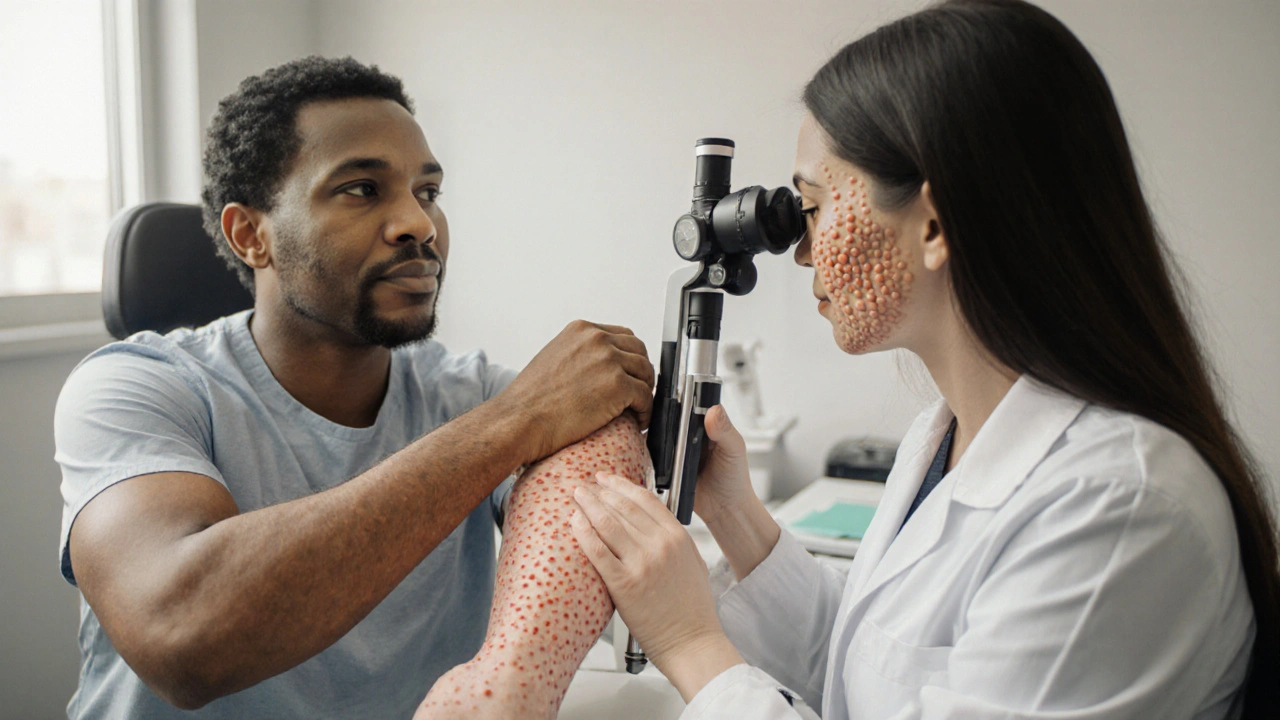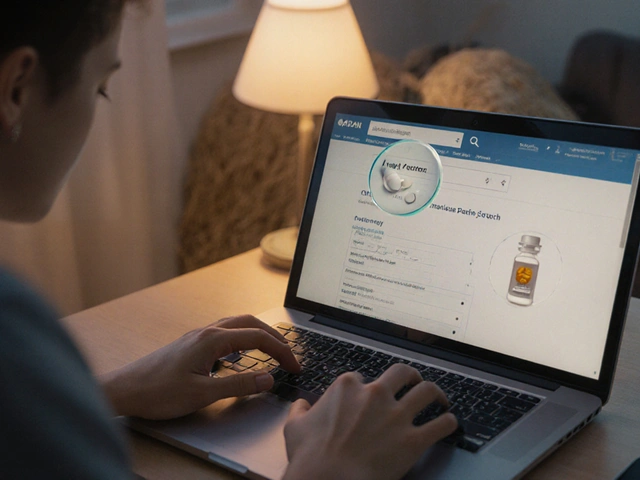Dermatitis Herpetiformis is a chronic, intensely itchy skin disease tied to gluten intolerance, marked by clusters of tiny blisters and reddened papules, typically on elbows, knees, buttocks, and scalp. Although the rash looks like a simple allergic reaction, it signals a deeper autoimmune process that often co‑exists with celiac disease.
Recognising the Key Dermatitis Herpetiformis symptoms
The hallmark signs are easy to spot once you know what to look for. Below is a quick checklist you can use during a self‑exam or when describing the problem to a doctor:
- Intense pruritus that spikes at night.
- Grouped vesicles (tiny fluid‑filled blisters) that quickly turn into crusted erosions.
- Symmetrical distribution on extensor surfaces - elbows, knees, upper back, and sacrum.
- Fine, white‑to‑yellowish papules that may precede blisters.
- Occasional burning sensation rather than simple itching.
Because the rash can be mistaken for eczema or psoriasis, a dermatologist often orders a skin biopsy to confirm the diagnosis.
Why Does It Happen? The Underlying Causes
At its core, Dermatitis Herpetiformis is an extra‑intestinal manifestation of celiac disease. The immune system produces IgA antibodies targeting tissue transglutaminase (tTG) and epidermal transglutaminase (eTG) when gluten is ingested. These antibodies form immune complexes that lodge in the dermal papillae, drawing neutrophils and causing the characteristic vesicles.
Key genetic factors include the presence of HLA‑DQ2/DQ8 genes that predispose individuals to celiac‑related autoimmunity. Roughly 90% of patients with Dermatitis Herpetiformis carry one of these alleles.
Other contributors:
- Persistent gluten exposure from hidden sources (soy sauce,processed foods).
- Concurrent micronutrient deficiencies, especially iron and folate, due to villous atrophy in the small intestine.
- Stress and hormonal fluctuations that can amplify itching.
How Doctors Confirm the Diagnosis
Diagnosing Dermatitis Herpetiformis is a two‑step process: clinical assessment followed by laboratory verification.
Skin Biopsy with Direct Immunofluorescence
During a punch biopsy, a small piece of skin is examined under a microscope. Direct immunofluorescence reveals granular IgA deposits in the dermal papillae, a pattern that is virtually pathognomonic.
Serologic Tests
Blood work looks for elevated tTG‑IgA antibodies associated with celiac disease. A positive result strengthens the link between the skin findings and gluten sensitivity.
Small‑Intestine Evaluation
In many cases, an upper endoscopy shows villous atrophy flattening of the intestinal lining, confirming silent or overt celiac disease.

Effective Treatment Strategies
The goal is twofold: stop the rash and prevent long‑term complications of gluten‑related autoimmunity.
Pharmacologic Options
- Dapsone an antibacterial sulfone that quickly dampens neutrophil activity. Most patients see relief within days, but regular blood counts are required to watch for hemolysis.
- Topical corticosteroids for breakthrough spots, especially on delicate skin.
- Antihistamines at night to curb itching and improve sleep.
Dietary Management
Eliminating gluten is the cornerstone of long‑term control. Gluten‑free diet excludes wheat, barley, rye, and their derivatives. After strict adherence for 6-12 months, many patients can taper or discontinue dapsone.
Key tips for success:
- Read labels for hidden gluten (e.g., malt flavoring, hydrolyzed vegetable protein).
- Prefer naturally gluten‑free grains-rice, quinoa, buckwheat, millet.
- Consult a dietitian to ensure adequate fiber, iron, and B‑vitamins.
Lifestyle Adjustments
- Cool showers and oatmeal‑based bath soaks to soothe itching.
- Loose, breathable clothing to reduce friction.
- Stress‑reduction techniques (mindfulness, yoga) that help modulate immune response.
Where Dermatitis Herpetiformis Fits in the Skin‑Disease Landscape
| Condition | Typical Distribution | Primary Trigger | IgA Deposits | First‑Line Treatment |
|---|---|---|---|---|
| Dermatitis Herpetiformis | Elbows, knees, buttocks, scalp | Gluten ingestion | Yes (granular) | Dapsone + gluten‑free diet |
| Psoriasis | Scalp, elbows, lower back, nails | Genetic + immune dysregulation | No | Topical steroids, vitamin D analogues |
| Atopic Dermatitis | Faces of infants, flexural areas in adults | Allergens, barrier dysfunction | No | Moisturizers, topical steroids, antihistamines |
The table highlights why a skin‑only view can be misleading. Only Dermatitis Herpetiformis shows the characteristic IgA deposits and responds dramatically to a gluten‑free diet.
Connecting Conditions and Next Steps for Readers
If you’ve been diagnosed with Dermatitis Herpetiformis, you’re likely to encounter related topics such as:
- Celiac disease an autoimmune reaction to gluten affecting the small intestine.
- Non‑celiac gluten sensitivity, which can cause similar GI discomfort without villous atrophy.
- Other autoimmune skin disorders like linear IgA disease, which also features IgA deposits but differs in clinical pattern.
Exploring these areas helps you understand the broader immune landscape and may guide future screenings (e.g., bone density tests for osteoporosis, a known long‑term risk of untreated celiac disease).

Frequently Asked Questions
Can Dermatitis Herpetiformis disappear without medication?
Yes, many patients achieve complete remission by strictly following a gluten‑free diet. However, the skin may take several months to clear, and a short course of dapsone often speeds up relief.
Is Dermatitis Herpetiformis contagious?
No. The rash is an autoimmune reaction, not an infection, so it cannot be spread from person to person.
Do I need a colonoscopy if I have Dermatitis Herpetiformis?
A colonoscopy is not routinely required. The focus is on duodenal biopsies to assess villous atrophy associated with celiac disease.
Can children develop Dermatitis Herpetiformis?
It is rare but possible. When it occurs, early diagnosis is vital to prevent growth setbacks linked to malabsorption.
What are the side effects of long‑term dapsone use?
The main concerns are hemolytic anemia (especially in G6PD‑deficient patients), methemoglobinemia, and occasional liver enzyme elevation. Regular blood monitoring mitigates these risks.
How often should I see a dermatologist after diagnosis?
Initially every 2-4 weeks to adjust dapsone dosage, then every 3-6 months once the rash is under control and the gluten‑free diet is stable.






Richard Leonhardt
Hey there, if you just got diagnosed with DH the first thing to do is to start a strict gluten‑free diet; it’s the backbone of long‑term remission. Even if you’re busy, you can still find plenty of GF breads and pastas at most supermarkets, just read the label carefully. I always reccomend checking for hidden sources like soy sauce or malt flavoring because they can sneak right in. Pair the diet with a dapsone trial under your doc’s supervision and you’ll notice the itching calm down within days. You’ll definatly feel better and the skin will clear up over time.
Shaun Brown
When discussing dermatitis herpetiformis, it's crucial to address the systemic implications beyond skin manifestations.
The condition is not merely an itchy rash that can be dismissed with a generic antihistamine, as many laypeople mistakenly believe.
Its pathogenesis is intimately linked to celiac disease, meaning that without strict gluten avoidance the immune cascade will perpetually regenerate the IgA deposits in the dermal papillae.
Moreover, the presence of HLA‑DQ2/DQ8 alleles serves as a genetic predisposition that cannot be overridden by topical treatments alone.
Studies have shown that patients who neglect dietary compliance experience not only persistent dermatologic symptoms but also an increased risk of osteoporosis, iron deficiency anemia, and even malignancy in the gastrointestinal tract.
The pharmacologic mainstay, dapsone, while remarkably effective at quelling the pruritus in days, carries a non‑trivial side‑effect profile that includes hemolytic anemia, methemoglobinemia, and hepatic enzyme elevation, necessitating rigorous laboratory monitoring.
Consequently, physicians who prescribe dapsone without educating patients on these risks are, at best, negligent and, at worst, complicit in iatrogenic harm.
It is also worth noting that the serologic assessment for tTG‑IgA should be performed before initiating a gluten‑free diet, because premature dietary changes can render the test falsely negative and delay proper diagnosis.
The biopsy with direct immunofluorescence remains the gold standard, yet many dermatologists dismiss it in favor of a quick empirical dapsone trial, compromising diagnostic accuracy.
Patients often report that the nocturnal itching is so severe it disrupts sleep architecture, leading to secondary mood disorders that are rarely addressed in routine follow‑ups.
A multidisciplinary approach involving gastroenterologists, dietitians, and mental health professionals is therefore indispensable for comprehensive care.
In practice, setting realistic expectations-such as explaining that the skin may take several months to fully clear even after strict gluten avoidance-prevents frustration and improves adherence.
The educational component should also encompass hidden sources of gluten, from hydrolyzed vegetable protein to maltodextrin, which can easily sabotage diet efforts.
While the literature frequently highlights the dramatic response to dapsone, the long‑term goal must remain the cessation of the drug through dietary mastery, not indefinite reliance on medication.
Failure to transition off dapsone not only poses chronic toxicity risks but also undermines the principle of treating the underlying autoimmune trigger.
In summary, a holistic, evidence‑based strategy that prioritizes gluten exclusion, vigilant monitoring, and patient empowerment is the only sensible path forward.
Damon Dewey
Consistent gluten avoidance is the single most effective way to keep the rash from flaring up.
Dan Barreto da Silva
Man, reading that deep‑dive made me feel like I’ve been living in a nightmare of endless itch that no one else seems to get. Every time I step out in public, I’m terrified the next flare will ruin my look and my confidence. I’ve tried every cream on the shelf, but nothing beats the raw torment of those midnight scratches. It’s absurd that a simple grain could hijack my entire existence, turning my skin into a battlefield. Honestly, if the world took gluten intolerance as seriously as a broken bone, we’d all be breathing easier.
Ariel Munoz
Look, the real problem isn’t the disease-it’s the broken healthcare system that lets people suffer for months before they get a proper biopsy. In the U.S. we have the resources to do direct immunofluorescence on every suspicious rash, yet doctors still waste time with cheap steroids. If we pushed for mandatory screening for HLA‑DQ2/DQ8 in anyone with chronic itching, we’d cut down on misdiagnoses and save countless dollars in long‑term complications.
Ryan Hlavaty
It’s disheartening to hear that some still prioritize cost over patient well‑being; putting a person’s quality of life on a spreadsheet is simply inhumane. Respecting the dignity of those battling autoimmune disorders should be non‑negotiable, regardless of borders.
Chris Faber
Honestly, I’ve seen a few friends manage their DH just fine with a solid gluten‑free plan and occasional dapsone dips, no drama needed.
aura green
Wow, isn’t it just *awesome* how the world finally gave us a step‑by‑step manual for a disease that used to be a secret club of itchy misery? 😊 I love that we now have tables comparing DH to psoriasis-because who doesn’t need a spreadsheet during a flare? The diet tips are practically a culinary adventure; nothing says “fun weekend” like hunting for gluten‑free breadcrumbs. And let’s not forget the emotional rollercoaster of night‑time antihistamines, because who needs sleep anyway? The dapsone shortcut is a lifesaver, assuming you enjoy routine blood work like a thrilling Netflix series. Your comprehensive guide even covers colonoscopies-clearly the most relevant info for skin fans. In short, thanks for turning a complicated autoimmune condition into a Pinterest‑style project; it’s exactly what we needed. 🙃
Edward Morrow
What a load of nonsense pretending that a little gluten could ruin lives-people just need a thicker skin and stop whining about “autoimmune triggers”.
Stephen Richter
While emotive language may be appealing, the clinical evidence unequivocally supports the link between gluten ingestion and dermatitis herpetiformis. Hence, dismissing patient experiences as mere complaint overlooks established pathophysiology.
KaCee Weber
Hey fam! 🌍 Let’s remember that behind every medical term is a person dealing with daily challenges, and community support can make a huge difference. Sharing recipes, swapping label‑reading tips, and cheering each other on when a flare strikes builds resilience. It’s amazing how a simple emoji can spread positivity across continents, reminding us we’re not alone in this gluten‑free journey. Keep the vibes up and the itch down! 🙌
jess belcher
Just a quick note: “it's” should be capitalized at the start of a sentence and “gluten‑free” is hyphenated when used as an adjective.
Sriram K
To sum up, the cornerstone of managing dermatitis herpetiformis lies in strict gluten elimination, judicious use of dapsone, and regular monitoring for nutritional deficiencies. Working with a dietitian ensures you hit all macro‑ and micronutrient needs while avoiding hidden gluten sources. Periodic blood work tracks dapsone safety, and follow‑up skin exams confirm disease control. This integrated approach optimizes both skin health and overall well‑being.
Deborah Summerfelt
Isn’t it curious how we label an itchy rash as “autoimmune” and then accept it as fate, rather than questioning the societal pressures that dictate our diets?